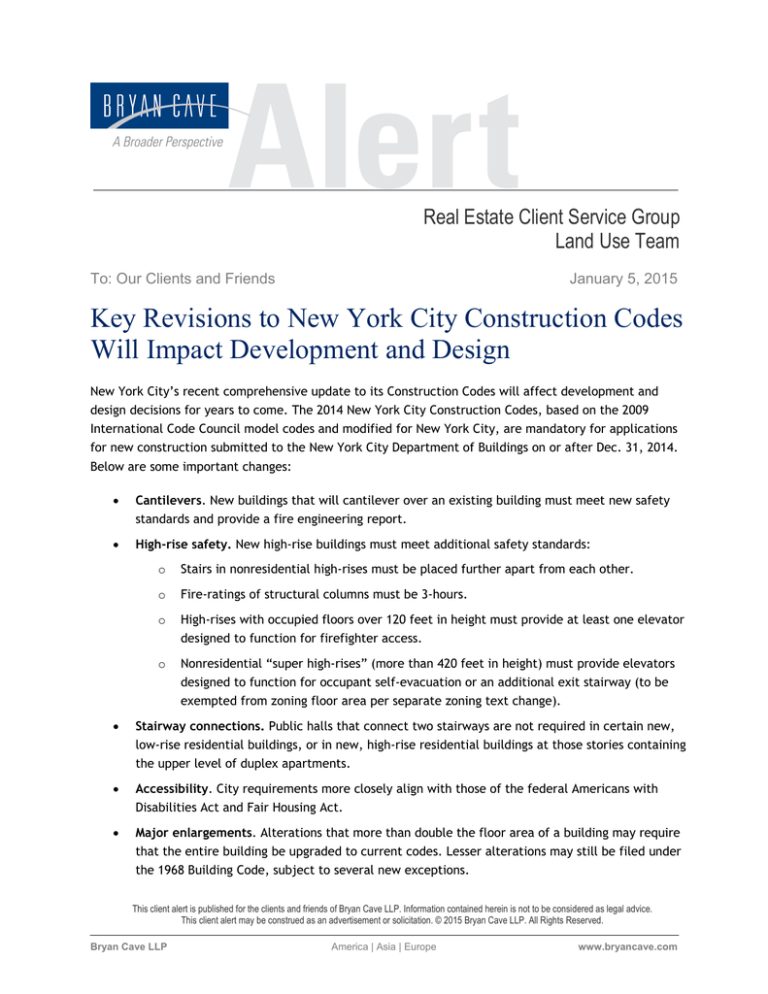
Real Estate Client Service Group
Land Use Team
To: Our Clients and Friends
January 5, 2015
Key Revisions to New York City Construction Codes
Will Impact Development and Design
New York City’s recent comprehensive update to its Construction Codes will affect development and
design decisions for years to come. The 2014 New York City Construction Codes, based on the 2009
International Code Council model codes and modified for New York City, are mandatory for applications
for new construction submitted to the New York City Department of Buildings on or after Dec. 31, 2014.
Below are some important changes:
Cantilevers. New buildings that will cantilever over an existing building must meet new safety
standards and provide a fire engineering report.
High-rise safety. New high-rise buildings must meet additional safety standards:
o
Stairs in nonresidential high-rises must be placed further apart from each other.
o
Fire-ratings of structural columns must be 3-hours.
o
High-rises with occupied floors over 120 feet in height must provide at least one elevator
designed to function for firefighter access.
o
Nonresidential “super high-rises” (more than 420 feet in height) must provide elevators
designed to function for occupant self-evacuation or an additional exit stairway (to be
exempted from zoning floor area per separate zoning text change).
Stairway connections. Public halls that connect two stairways are not required in certain new,
low-rise residential buildings, or in new, high-rise residential buildings at those stories containing
the upper level of duplex apartments.
Accessibility. City requirements more closely align with those of the federal Americans with
Disabilities Act and Fair Housing Act.
Major enlargements. Alterations that more than double the floor area of a building may require
that the entire building be upgraded to current codes. Lesser alterations may still be filed under
the 1968 Building Code, subject to several new exceptions.
This client alert is published for the clients and friends of Bryan Cave LLP. Information contained herein is not to be considered as legal advice.
This client alert may be construed as an advertisement or solicitation. © 2015 Bryan Cave LLP. All Rights Reserved.
Bryan Cave LLP
America | Asia | Europe
www.bryancave.com
Mold-resistance. Only mold-resistant wallboard may be used in basements, cellars, bathrooms and
certain other locations. This applies to new buildings and alterations.
Ductwork. Redundant fire/smoke dampers may be omitted in new ductwork.
Piping insulation. Any uninsulated piping exposed during alteration work must be insulated as
required, before the walls are closed up.
Sidewalk sheds. These must be inspected daily.
Out-of-date certificates of occupancy. An owner changing a building’s address, block/lot or the
metes and bounds of a zoning lot listed on the current certificate of occupancy must obtain an
amended certificate of occupancy within one year of the change.
Flood resiliency. Several new post-Sandy measures have been added:
o
Critical mechanical equipment in new buildings in flood zones must be elevated, and may
not be located in dry-floodproofed cellars.
o
Toilet rooms must include at least one toilet and sink capable of non-electric operation in
case of power failure; this applies to new buildings and alterations.
o
New retroactive requirements for certain hospitals, nursing homes and assisted living
facilities include provision of future hookups for emergency generators, and in some cases
emergency boilers and cooling systems.
o
New retroactive requirements for all residential buildings that rely on electric pumps for
continued water supply include installation of one public sink or other fixture that is
provided with enough City water pressure to operate without electricity.
The City also updated its Energy Conservation Code for “commercial” buildings (including residential
buildings over three stories tall) to be consistent with similar updates made to the New York State Energy
Conservation Construction Code. The result of the New York City update is a more stringent energy code
that will result in more than an 18 percent average annual energy savings. The revised New York City
Energy Conservation Code is mandatory for all construction applications submitted to the New York City
Department of Buildings on or after Jan. 1, 2015.
Click here to view the 2014 New York City Construction Codes. Informational videos on the new codes
taped on June 10, 2014 may be viewed here, but note that the videos state an effective date of Oct. 1,
2014, which was changed to Dec. 31, 2014 by subsequent legislation. Click here to view the revised New
York City Energy Conservation Code.
For further information on this alert or other code and zoning issues, contact a member of the Bryan Cave
Land Use Team or New York Counsel James P. Colgate, AIA, at james.colgate@bryancave.com or (212)
541-2127. Mr. Colgate served as assistant commissioner of technical affairs and code development at the
New York City Department of Buildings from 2008 to 2014, and has been a member of the International
Building Code (General) Code Development Committee and the American Society of Civil Engineers
Committee on Flood Resistant Design & Construction Standards.
-2Bryan Cave LLP
America | Asia | Europe
www.bryancave.com




